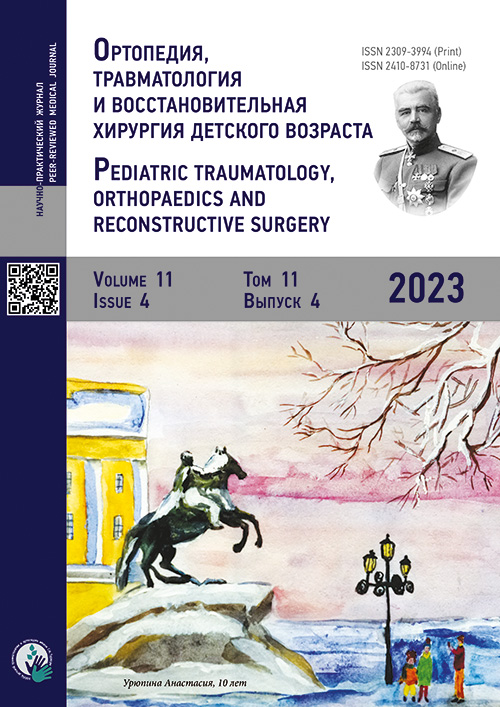在实验中对兔子腹侧和背侧入路脊髓挫伤模型进行比较评估
- 作者: Shabunin A.S.1,2, Savina M.V.1, Rybinskikh T.S.3, Dreval A.D.1, Safarov V.D.1,2, Safonov P.А.1, Fedyuk A.M.1, Sitovskaia D.A.4, Dyachuk N.M.1, Baidikova A.S.1, Konkova L.S.1, Vlasova O.L.2, Vissarionov S.V.1
-
隶属关系:
- H. Turner National Medical Research Center for Сhildren’s Orthopedics and Trauma Surgery
- Peter the Great Saint Petersburg Polytechnic University
- H. Turner National Medical Research Center for Children’s Orthopedics and Trauma Surgery
- Polenov Neurosurgical Institute
- 期: 卷 11, 编号 4 (2023)
- 页面: 487-500
- 栏目: Experimental and theoretical research
- URL: https://bakhtiniada.ru/turner/article/view/251907
- DOI: https://doi.org/10.17816/PTORS568295
- ID: 251907
如何引用文章
详细
论证。目前研究脊柱脊髓损伤的实验模型多以大鼠或小鼠脊髓损伤为基础。实验性脊髓损伤模型通常是从背侧入路进行的,这就排除了断裂椎体碎片压迫造成的脊髓损伤,并从临床实践的角度大大限制了结果的应用。
本研究旨在对兔子腹侧入路脊髓损伤实验模型和背侧入路脊髓损伤模型进行对比分析。
材料和方法。研究对象是20只体重为3.5-4.5千克的苏联栗鼠种雌兔。这些兔子被分为两组,分别从LII椎骨水平的腹侧和背侧入路进行标准化脊髓损伤(每组10只)。所有实验动物均记录伤前、伤后即刻及伤后3、8小时的体感、运动诱发电位和H反射。我们还进行了组织学研究,对损伤脊髓切片活检标本进行了定性和半定量分析,并评估了动态萎缩神经元的数量。我们对腹侧和背侧损伤脊髓的神经电生理和组织学研究结果进行了统计处理。
结果。在腹侧入路脊髓损伤模型中,与背侧入路模型相比,可观察到更明显的脊髓损伤。在损伤水平和损伤区域下方都发现了神经元功能障碍。根据组织学研究,腹侧入路模型的出血程度低于背侧入路模型。
结论。研究结果表明,在腹侧入路损伤的实验模型中,脊髓损伤的严格挫伤机制更为明显,所获得的模型与临床情况最为接近。建立的实验动物脊髓挫伤性损伤模型可进一步用于慢性实验。
作者简介
Anton S. Shabunin
H. Turner National Medical Research Center for Сhildren’s Orthopedics and Trauma Surgery; Peter the Great Saint Petersburg Polytechnic University
编辑信件的主要联系方式.
Email: anton-shab@yandex.ru
ORCID iD: 0000-0002-8883-0580
SPIN 代码: 1260-5644
MD, Research Associate
俄罗斯联邦, Saint Petersburg; Saint PetersburgMargarita V. Savina
H. Turner National Medical Research Center for Сhildren’s Orthopedics and Trauma Surgery
Email: drevma@yandex.ru
ORCID iD: 0000-0001-8225-3885
SPIN 代码: 5710-4790
MD, PhD, Cand. Sci. (Med.)
俄罗斯联邦, Saint PetersburgTimofey S. Rybinskikh
H. Turner National Medical Research Center for Children’s Orthopedics and Trauma Surgery
Email: timofey1999r@gmail.com
ORCID iD: 0000-0002-4180-5353
SPIN 代码: 7739-4321
6th year student
俄罗斯联邦, Saint PetersburgAnna D. Dreval
H. Turner National Medical Research Center for Сhildren’s Orthopedics and Trauma Surgery
Email: anndreval@yandex.ru
ORCID iD: 0009-0007-3985-634X
SPIN 代码: 4175-6620
student
俄罗斯联邦, Saint PetersburgVladislav D. Safarov
H. Turner National Medical Research Center for Сhildren’s Orthopedics and Trauma Surgery; Peter the Great Saint Petersburg Polytechnic University
Email: vladsafarov.vs@mail.ru
ORCID iD: 0009-0006-2948-133X
SPIN 代码: 5240-1801
student
俄罗斯联邦, Saint Petersburg; Saint PetersburgPlaton А. Safonov
H. Turner National Medical Research Center for Сhildren’s Orthopedics and Trauma Surgery
Email: safo165@gmail.com
ORCID iD: 0009-0006-7554-1292
SPIN 代码: 6088-1297
student
俄罗斯联邦, Saint PetersburgAndrey M. Fedyuk
H. Turner National Medical Research Center for Сhildren’s Orthopedics and Trauma Surgery
Email: Andrej.fedyuk@gmail.com
ORCID iD: 0000-0002-2378-2813
SPIN 代码: 3477-0908
resident
俄罗斯联邦, Saint PetersburgDaria A. Sitovskaia
Polenov Neurosurgical Institute
Email: daliya_16@mail.ru
ORCID iD: 0000-0001-9721-3827
SPIN 代码: 3090-4740
MD, pathologist, researcher
俄罗斯联邦, Saint PetersburgNikita M. Dyachuk
H. Turner National Medical Research Center for Сhildren’s Orthopedics and Trauma Surgery
Email: wrwtit@yandex.ru
ORCID iD: 0009-0009-4384-9526
student
俄罗斯联邦, Saint PetersburgAlexandra S. Baidikova
H. Turner National Medical Research Center for Сhildren’s Orthopedics and Trauma Surgery
Email: baidikovaalexandra@yandex.ru
ORCID iD: 0009-0008-8785-0193
SPIN 代码: 7805-1341
student
俄罗斯联邦, Saint PetersburgLidia S. Konkova
H. Turner National Medical Research Center for Сhildren’s Orthopedics and Trauma Surgery
Email: lidia.kireeva@yandex.ru
ORCID iD: 0009-0007-5400-3513
SPIN 代码: 3527-7121
MD, PhD student
俄罗斯联邦, Saint PetersburgOlga L. Vlasova
Peter the Great Saint Petersburg Polytechnic University
Email: vlasova.ol@spbstu.ru
ORCID iD: 0000-0002-9590-703X
SPIN 代码: 7823-8519
PhD, Dr. Sc. (Phys. and Math.), Assistant Professor
俄罗斯联邦, Saint PetersburgSergei V. Vissarionov
H. Turner National Medical Research Center for Сhildren’s Orthopedics and Trauma Surgery
Email: vissarionovs@gmail.com
ORCID iD: 0000-0003-4235-5048
SPIN 代码: 7125-4930
MD, PhD, Dr. Sci. (Med.), Professor, Corresponding Member of RAS
俄罗斯联邦, Saint Petersburg参考
- Alizadeh A, Dyck SM, Karimi-Abdolrezaee S. Traumatic spinal cord injury: an overview of pathophysiology, models and acute injury mechanisms. Front Neurol. 2019;10:282. doi: 10.3389/fneur.2019.00282
- Tator CH. Review of treatment trials in human spinal cord injury: issues, difficulties, and recommendations. Neurosurgery. 2006;59(5):957–982. doi: 10.1227/01.NEU.0000245591.16087.89
- Verstappen K, Aquarius R, Klymov A, et al. Systematic evaluation of spinal cord injury animal models in the field of biomaterials. Tissue Eng Part B Rev. 2022;28(6):1169–1179. doi: 10.1089/ten.TEB.2021.0194
- Sharif-Alhoseini M, Khormali M, Rezaei M, et al. Animal models of spinal cord injury: a systematic review. Spinal Cord. 2017;55(8):714–721. doi: 10.1038/sc.2016.187
- Li JJ, Liu H, Zhu Y, et al. Animal models for treating spinal cord injury using biomaterials-based tissue engineering strategies. Tissue Eng Part B Rev. 2022;28(1):79–100. doi: 10.1089/ten.TEB.2020.0267
- Vissarionov SV, Rybinskikh TS, Asadulaev MS, et al. Modeling spinal cord injuries: advantages and disadvantages. Pediatric Traumatology, Orthopaedics and Reconstructive Surgery. 2020;8(4):485–494. (In Russ.) doi: 10.17816/PTORS34638
- Kjell J, Olson L. Rat models of spinal cord injury: from pathology to potential therapies. Dis Model Mech. 2016;9(10):1125–1137. doi: 10.1242/dmm.025833
- Ballermann M, Fouad K. Spontaneous locomotor recovery in spinal cord injured rats is accompanied by anatomical plasticity of reticulospinal fibers. Eur J Neurosci. 2006;23(8):1988–1996. doi: 10.1111/j.1460-9568.2006.04726.x
- Hiraizumi Y, Fujimaki E, Tachikawa T. Long-term morphology of spastic or flaccid muscles in spinal cord-transected rabbits. Clin Orthop Relat Res. 1990;(260):287–296.
- Greenaway JB, Partlow GD, Gonsholt NL, et al. Anatomy of the lumbosacral spinal cord in rabbits. J Am Anim Hosp Assoc. 2001;37(1):27–34. doi: 10.5326/15473317-37-1-27
- Mazensky D, Flesarova S, Sulla I. Arterial blood supply to the spinal cord in animal models of spinal cord injury. A Review. Anat Rec (Hoboken). 2017;300(12):2091–2106. doi: 10.1002/ar.23694
- Vink R, Noble LJ, Knoblach SM, et al. Metabolic changes in rabbit spinal cord after trauma: magnetic resonance spectroscopy studies. Ann Neurol. 1989;25(1):26–31. doi: 10.1002/ana.410250105
- Sung DH, Lee KM, Chung SH, et al. Change of stretch reflex in spinal cord injured rabbit: experimental spasticity model duk. Journal of the Korean Academy of Rehabilitation Medicine. 2002;26(1):37–45.
- Shek JW, Wen GY, Wisniewski HM. Atlas of the rabbit brain and spinal cord. Karger Basel; 1986.
- Patent RF na izobretenie No. 2021124504 / 16.08.2021. Vissarionov SV, Rybinskikh TS, Asadulaev MS. Sposob modelirovaniya travmaticheskogo povrezhdeniya spinnogo mozga iz ventral’nogo dostupa v poyasnichnom otdele pozvonochnika. (In Russ.) [cited 2023 Nov 4]. Available from: https://i.moscow/patents/ru2768486c1_20220324
- Mazensky D, Danko J, Petrovova E, et al. Arterial peculiarities of the thoracolumbar spinal cord in rabbit. Anat Histol Embryol. 2014;43(5):346–351. doi: 10.1111/ahe.12081
- Mazensky D, Petrovova E, Danko J. The anatomical correlation between the internal venous vertebral system and the cranial venae cavae in rabbit. Anat Res Int. 2013;2013. doi: 10.1155/2013/204027
- Turan E, Ünsal C, Üner AG. H-reflex and M-wave studies in the fore- and hindlimbs of rabbit. Turkish J Vet Anim Sci. 2013;37(5):559–563. doi: 10.3906/vet-1210-27
- Gnezditskii VV, Korepina OS. Atlas po vyzvannym potentsialam mozga (prakticheskoe rukovodstvo, osnovannoe na analize konkretnykh klinicheskikh nablyudenii). Ivanovo: PresSto; 2011. (In Russ.)
补充文件




















